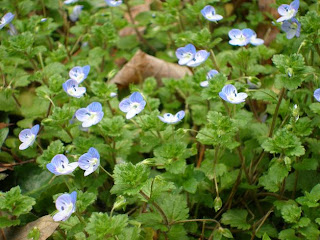 Spring is when I notice the tiny flowers that might get ignored later in the year. After the gloom of winter, with so little color, I am always cheered by the tiniest wild blooms of spring. As much as I love the yellow glow of daffodils, the site of the smallest blooms, shaken in the strong winds of February and March, are the more authentic voice of Spring.
Spring is when I notice the tiny flowers that might get ignored later in the year. After the gloom of winter, with so little color, I am always cheered by the tiniest wild blooms of spring. As much as I love the yellow glow of daffodils, the site of the smallest blooms, shaken in the strong winds of February and March, are the more authentic voice of Spring.I vowed one year to learn every wild flower species as it opened, and to reach the following winter with a complete litany of names. I tried this several years in a row, actually, but always spun out of control and lost it in the acceleration of April and May. At the beginning it seems manageable, like lifting that baby bull every day while you bottle feed it. But all at once it's too big to get your arms around, much less lift.
 Some of the very first are the bright blue, quarter inch blooms of Veronica (photo above, taken outside the Science Museum). There are actually five petals, but two are overlapped, so it appears to be four. Then there are field pansies, violas, and johnny jump-ups, like these tiny specimens found in a crack at the top of Church Hill.
Some of the very first are the bright blue, quarter inch blooms of Veronica (photo above, taken outside the Science Museum). There are actually five petals, but two are overlapped, so it appears to be four. Then there are field pansies, violas, and johnny jump-ups, like these tiny specimens found in a crack at the top of Church Hill.Henbit, Gill over the Ground, Bluets, Chickweed, Bitter Cress, Dandelions, Hepatica, Violets, and Purple Deadnettle are some of the other earliest risers. Probably half of those are actually immigrants from Europe. Then comes the onslaught, with names like Wood Bettony, Catesby's Trillium, Wake Robin, Bastard Toadflax, Carolina Jasmine, Pink Lady Slipper, Trumpet Creeper, Lyre Leaved Sage, Indian's Paintbrush, Mock Strawberry, Cinquefoil, Butter and Eggs, Polygala, Ladies Tresses, Atamasco Lily, Blue Flax, Steeplebush, Multiflora Rose, Deptford Pink, Trailing Arbutus, Grass of Parnassus, Fetter Bush, and on and on. By the time the Queen Anne's Lace is fully open on our roadsides I've lost the race, also in part because the poison ivy is keeping me out of the woods.
But for now, I admire the pluck and delicate beauty of the quiet early bloomers, even as I pull them from our flower beds, smelling the peppery aroma of the cresses, and the sweet green peas fragrance of the chickweeds. The fresh appetizing scents are as welcome after the sterility of winter as the sight of the tiny colorful flowers.

No comments:
Post a Comment